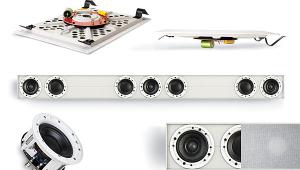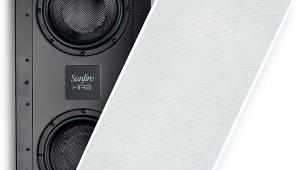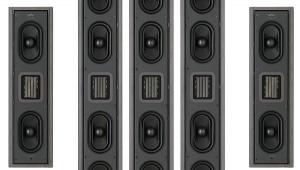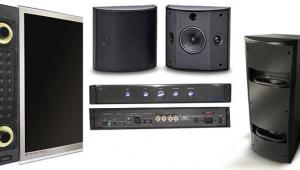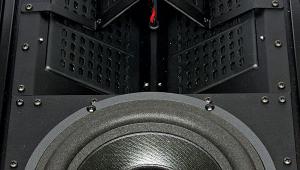Episode ES-HT700 In-Ceiling Speaker System Page 3

While the blending of the subs was mighty impressive, the subs themselves don’t have quite the low-end kick that some freestanding subs (like an MK Sound or Definitive) have, or even the BG Radia in-wall sub I reviewed in Home Theater’s January 2010 issue. In fact, Episode rates these as going down to 30 hertz at –6 decibels. But it’s difficult to fit a sub in a standard wall without using a 6-foot-tall back box. As they are, paired with the E-2100 amps, the ES-SUB-IW-DUAL8 subs are certainly contenders amidst the field of retrofit-capable in-wall subs.
One of the things Episode mentioned several times was how the speakers in each series (in this case, the 700 series) were designed to blend as well together as possible. They sure seem to have accomplished this in the case of the in-ceiling speakers I used as surrounds (ES-700-IC-6) and back speakers (ES-700-POINT-6). The ES-700-POINT-6 model uses a recessed, angled basket that, much like the ES-HT700-ICLCR-5’s, you can install with the drivers pointing in the direction of the listening area—which is why I used them for back speakers. All the speakers use the same very smooth 1-inch catenary-shaped dome tweeter. “Me likes it muchly,” as one of my friends would say.
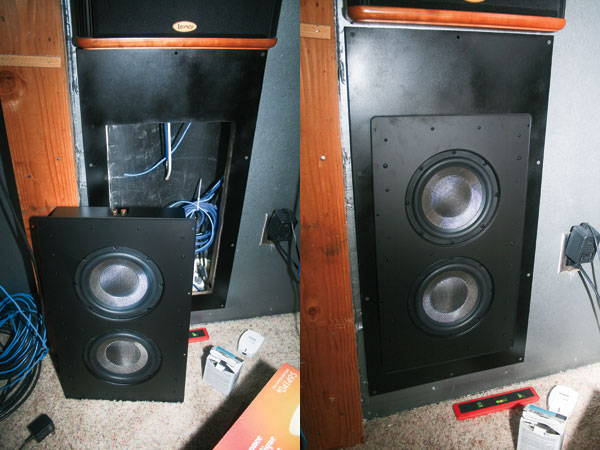
Not long before I finished my listening tests, Episode sent a brand-new in-ceiling speaker, the ES-700-ICSURR-6, which can be used as either a dipole or bipole. The speaker features a pair of 0.75-inch tweeters mounted side by side in a pivoting assembly in front of a 6.5-inch woofer. Although these tweeters are standard domes—not the catenary type in the rest of the ES-700 series—they seemed to blend as well with the system as the original standard two-way model I installed. Episode recommends that you point the tweeters toward the listening position when you use the speakers in bipole mode and toward the side wall for a more diffuse sound in dipole mode. In my case, probably because I had to install the speakers almost above the couch, the dipole mode did a better job of bringing the soundfield down from the ceiling and into the room. Considering that the price for the ES-700-ICSURR-6s ($699 per pair) is the same as that for the IC-6 model, it’s a no-brainer to use the former in the system. It takes a bit of experimenting to get the tweeter positioning just right before you put on the grilles and call it a day, but it’ll be worth it.
Ceiling Speaker Salvation
All of this brings us back to our opening dilemma: Can a system of in-ceiling speakers and inwall subs really make a serious home theater? As good as the ES-HT700-ICLCR-5s are in terms of imaging, detail, and clarity, they won’t fool you into totally believing the sound is coming from directly in front of you as it would with a set of freestanding speakers. On the other hand, these are some of the best in-ceiling speakers I’ve heard in a long time. Instead of getting the impression that the speakers are above your head, they create the sensation that they’re somewhere about a third of the way down on the front wall. My Samsung plasma is mounted at about the same spot, so in my case, it sounded like the dialogue was coming directly from the HDTV.
Do I prefer having the plane of sound slightly skewed upward like this? No. The ES-HT700-ICLCR-5s certainly aren’t a straight-out replacement for freestanding speakers—but the guys at Episode didn’t design them to be and don’t claim them to be. What they are is one of the best solutions for those theaters where there simply is no place for speakers other than in the ceiling.
With the exception of the off-kilter sound plane, the ES-HT700-ICLCR-5s will give most other speakers in the price range a serious run for their money. We took a chance (well, I took the chance since it was my ceiling) on reviewing the Episode speakers. If you’re out of luck when it comes to floor and wall space in your home theater, take a chance on the ES-HT700-ICLCR-5s. I think they’re a sure thing. Just make up a decent name for them before you invite your friends over for a demo.




